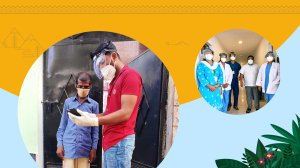Editor’s Note: This article references Dreampass and Salesforce’s Health & Safety Playbook, which have been expanded upon with the launch of Safety Cloud. For the latest on Salesforce’s health & safety-related innovations, check out this press release and FAQ.
As Head of Global Real Estate, I helped develop Salesforce’s plan to ensure our employees can return to our offices safely. As countries, states, and cities have shifted in their approaches to COVID-19 restrictions due to ongoing surges, our team planned how to reopen our global campus of over 160 locations at the start of the pandemic, while supporting the health and safety of our 50,000+ employees and the communities where we live and work.
We make decisions based on multiple factors. It’s a weighted matrix that accounts for the unique guidelines set forth by every location in which we operate, local governance, guidance from health advisors, and the wellbeing of our employees.
This process incorporates a phased approach for return. We’re not opening up the doors to have everyone return to their desks the same day an office reopens. It’s more like using a light dimmer than a light switch and technology is helping us do that more easily.
Internally, we leverage our own technology to help us for almost everything we do. So when COVID started, that’s exactly what we did. To bring people together again in person, we looked at the Salesforce Customer 360 with its connected digital tools to plan for a safer reopening of our offices.
We understand the need to gather and collaborate is rising, and as we look towards this next step — and in the spirit of sharing in order to help others — below are the guiding principles we’re using to reopen our offices.
Of course, there are still a number of unknowns. Throughout this process, we know that constant iteration is the new reality. But most of all, we know that the safety of our employees, customers, partners and communities must always be our top priority.
1. Create a guideline matrix for re-opening
In partnership with our reopening steering committee which is made up of internal and external advisors, we have developed a science-based, data driven approach and a decision-making process to weigh the many inputs that need to be evaluated before we consider reopening a Salesforce location.
This Guideline Matrix incorporates local governance, medical expert advice, local leadership feedback, employee sentiment and other crucial factors. It is also frequently updated to include new COVID-19 vaccination and testing mandates as needed. All these metrics are weighed and visualized in a red, yellow, green Tableau dashboard, which is populated and reviewed separately for each location, as recommendations can vary greatly across regions and countries. This helps us more clearly identify which offices may be ready to reopen or close as environmental conditions change.
It was a priority to build this dashboard early, such that if the virus does resurge in a given location, we have a clear and robust process we can use as we make new decisions about partially or fully closing a location again. If and when conditions do change or cross a threshold, teams are automatically notified and we can take action faster.
2. Build the strongest supply chain you can
You can have the best plan in the world, but if you don’t have critical items like cleaning supplies, hand sanitizer and face coverings you won’t be able to open your doors.
We discovered early on that our supply chain had to be rechecked, rethought, and in some cases, rebuilt. In addition to the items we were always counting on, we realized we also had to go out and source some new products – like face coverings – and change quantities of existing products to meet new cleaning and health protocols. We also created new partnerships with third parties like health labs for onsite testing.
3. Redesign The office
We have already redesigned all our workspaces, including employee work floors, meeting rooms, kitchens and social lounges, coffee bars, building lobbies, elevator cabs, reception areas and more to incorporate the new realties of physical distancing. We’ve also incorporated new practices including shift scheduling and capacity management to control density. And we’ve increased both the frequency and the depth of the cleaning services in our offices. Since COVID-19 is airborne, we are working with all our building management teams to optimize core building systems, like airflow to avoid contamination. We’ve defined new benchmarks around that too. Consider creating a checklist for essential systems including HVAC air filtration systems, plumbing, kitchen equipment, and key engineering systems.
When possible we’ve started to leverage more outdoor space for work and events as well. In fact, for our most recent Dreamforce event, over 90% of the in-person experience was outside. The only time anyone was inside was to register or to use a restroom. Also, teams that can work remotely continue to do so until further phases of a return to work plan is implemented.

4. Set expectations and over-communicate
What we communicate, when we communicate, and how we communicate are critical to employee well-being. We want our employees to feel safe and feel good about returning to an office. Once an office has been identified as ready to reopen, we send out reopening communications to communicate transparently and set expectations.
That communications journey is crafted as part of an integrated plan to support all phases of the experience. We’ve thoughtfully planned how to make the “welcome back” experience as reassuring as possible.
We do that through sharing information and setting expectations about the new workplace environment before employees ever step foot in an office. This is done through email, Slack communications, webinars, reopening playbooks, Trailhead training, lots of visuals and more, so everyone is prepared and knows what to expect.
Once back in the office, employees are guided with onsite signage and communications, supported by workplace services teams communicating how the “new normal” of the workplace needs to operate. Over-communication in the spirit of employee wellness and reducing anxiety is the goal.
5. Create a safer in-person experience
Salesforce continues with a laser focus on taking care of our teams, customers, partners and communities onsite. We manage the onsite experience with our Vaccine Cloud and Work.com technologies. These tools help us bring people together in person more safely. This includes shift scheduling which allows us to manage arrival times and capacity levels, and wellness checks which survey employees to understand their personal health before entering an office. When permitted we also ask our employees to provide proof of their COVID health status, participate in onsite COVID testing, and follow mask requirements.
In the case that there is an infection, manual contact tracing helps us collect necessary data from an employee’s physical locations and movements in the workplace. With Contact Tracing we can automatically notify individuals who may have been potentially exposed. This helps us decrease the risk of large outbreaks and instill trust in those who chose to return to the office. So far, we’ve had over 7,000 employees volunteer to be part of our US-based Voluntary Vaccinated Program and return to the office.
As you can see, flexibility and trust are the keys to help reopen your office doors safely, and pivot to close them again if required. There are so many new challenges we’ve never had to solve before but with Salesforce’s orchestrated solutions and adherence to these best practices, we can look forward to re-entering our workspaces and seeing our colleagues again with confidence.



















